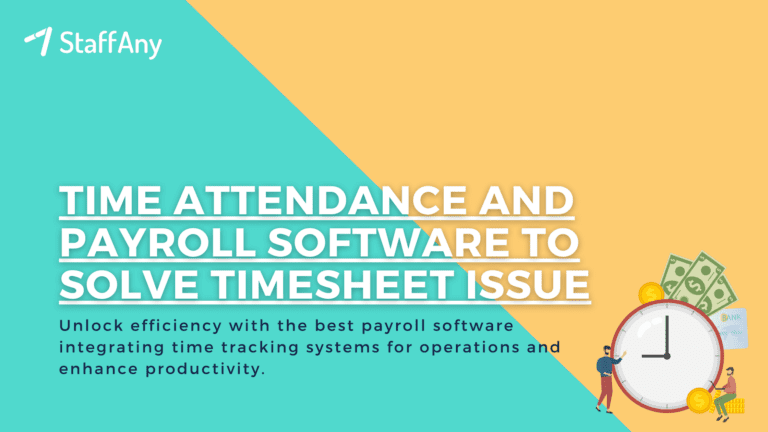If you run a business in the food and beverage industry, you’re probably familiar with the importance of having a well-trained and skilled team of employees. But just as important as having the right staff is ensuring they’re scheduled to work effectively.
In this article, we’ll explore the basics of staff scheduling and explain why it should be a top priority for F&B businesses. Let’s find out below!
What is Staff Scheduling?

At its most basic, staff scheduling is the process of assigning employees to work at specific times and on specific tasks. In the F&B world, this means determining which servers, bartenders, chefs, and other staff members are needed during each shift, and then creating a schedule that ensures all necessary roles are covered.
Of course, creating employee schedules involve more than simply filling in names on a calendar. It requires a deep understanding of the daily operations of the business, including peak hours, slow times, and special events. Factors like staff availability, skill levels, and workload also need to be taken into consideration.
To make things even more complex, the F&B industry is notorious for its high turnover rates, which means schedules need to be constantly updated and adjusted to account for new hires and departures.
Read more: 11 Factors to Consider When Scheduling Staff
Why Should Staff Scheduling Be Your Top Priority?
Now that we’ve established what employee scheduling is, let’s explore why it’s so crucial for success in the F&B world.
1. Maximising Efficiency and Productivity
Effective employee scheduling can help you optimise your labour costs by ensuring you have the right number of staff members on hand at all times.
This means avoiding overstaffing during slow periods, which can eat into profits, while also avoiding understaffing during peak hours, which can lead to overwhelmed employees and dissatisfied customers.
By taking a strategic approach to scheduling, you can also ensure that employees are assigned to tasks that match their skills and experience, which can improve employee productivity and reduce the risk of errors.
Read more: Understanding Manpower Planning and Its Importance in F&B
2. Boosting Employee Morale and Retention
Nobody likes being forced to work a shift they didn’t sign up for or feeling like they’re constantly being overworked. A poorly managed schedule can quickly lead to burnout, which can cause employees to quit or perform poorly on the job.
On the other hand, a well-designed schedule that takes into account employee preferences and availability can boost morale and improve retention rates. When employees feel that their needs are being taken into account, they’re more likely to feel valued and invested in the success of the business.
3. Enhancing Customer Experience
In the F&B world, the customer experience is everything. If your customers are consistently experiencing long wait times, slow service, or other issues related to understaffing, they’re unlikely to return.
By prioritising staff scheduling, you can ensure that you have enough staff on hand to provide prompt and attentive service, even during busy periods. This can help you build a loyal customer base that keeps coming back for more.
4. Compliance with Labor Laws
In addition to being a smart business move, effective staff scheduling is also a legal requirement. F&B businesses must comply with various labour laws, including those related to minimum wage, overtime, and meal and rest breaks.
By creating a schedule that meets these requirements, you can avoid costly penalties and lawsuits while also ensuring that your employees are treated fairly.
5. Streamlining Communication and Collaboration
Creating a staff schedule involves more than just assigning shifts. It also requires effective communication and collaboration between managers and employees.
By using scheduling software or other tools to streamline the process, you can make it easier for everyone involved to stay on the same page and avoid confusion or miscommunication. This can help reduce the risk of scheduling errors or conflicts, which can lead to missed shifts, lost productivity, and even legal issues.
Read more: Guideline for Overtime in Malaysia Labour Law
6. Adapting to Changing Business Needs
The F&B industry is notoriously unpredictable, with busy periods, slow periods, and unexpected events happening all the time. A well-designed staff schedule can help you adapt to these changing business needs quickly and effectively.
By having a clear understanding of your staffing requirements, you can adjust your schedule on the fly to accommodate unexpected changes, such as an unexpected influx of customers or a staff member calling in sick. This can help you maintain productivity and ensure that your business runs smoothly, no matter what challenges arise.
7. Leveraging Data to Improve Performance
By tracking your staff scheduling data over time, you can gain valuable insights into the performance of your business. For example, you can identify patterns or trends that suggest your business may be over or understaffed during certain periods, or that certain employees may need additional training or support.
Furthermore, leveraging this data can continuously help you improve your scheduling practices and optimise your staffing strategy for maximum efficiency, productivity, and profitability.
8. Staying Competitive in a Crowded Market
Finally, effective staff scheduling can help you stand out in a crowded F&B market. By providing superior customer service and maintaining high levels of productivity, you can build a reputation as a reliable and trustworthy business that customers can count on.
Over time, this can help you attract more customers and build a loyal following, even in the face of tough competition.
Read more: How to Prepare Shift Roster in the F&B Industry
Essential Staff Schedule Management Tips for Business Owners
Optimizing staff scheduling can greatly improve operational efficiency and employee satisfaction. Here are some steps to help you optimize staff scheduling:
1. Analyze Workload and Demand
Any industry that hires hourly workers knows that everyone does not bring the same set of skills to the business.
Start by analyzing historical data to understand the workload patterns and customer demand. Identify peak hours, busy days, and seasonal variations in demand. This analysis will help you determine the appropriate staffing levels for different time periods.
2. Define Staffing Requirements
Based on the workload analysis, determine the optimal number of employees needed to handle the workload efficiently. Consider factors such as customer service levels, response times, and employee skill sets when determining the staffing requirements.
3. Create Flexible Schedules
Develop flexible schedules that accommodate both the organization’s needs and employees’ preferences. Consider implementing the rotation of employee shifts, split shifts, part-time schedules, and compressed workweeks to provide options for employees while ensuring adequate coverage.
4. Utilize Employee Scheduling Software
Invest in workforce scheduling software that can automate the process and optimize employee work schedules based on predefined rules and parameters. These tools can consider factors like employee availability, skills, certifications, and labor laws to generate efficient schedules.
Read more: Graveyard Shift: Meaning, Advantages, and Disadvantages
5. Employee Input and Preferences
Involve employees in the scheduling process by seeking their input and considering their preferences. Provide a platform for them to submit preferred availability or time-off requests, allowing you to accommodate their needs while balancing operational requirements.
6. Balance Workload and Skill Sets
Ensure that the right mix of skills and experience is scheduled for each shift. Consider employee skill levels, certifications, and expertise to ensure that the staff on duty can handle the workload effectively and provide high-quality service.
7. Monitor and Adjust Schedules
Regularly monitor and review the effectiveness of your schedules. Seek feedback from employees and supervisors to identify any issues or areas for improvement. Make adjustments as necessary to maintain an optimal balance between staffing levels and operational demands.
8. Track Employee Performance and Attendance
Implement a system to track employee performance and attendance. Identify any patterns of absenteeism or tardiness and address them promptly. Recognize and reward employees who consistently meet scheduling requirements and demonstrate exceptional performance.
9. Continuous Improvement
Staff scheduling optimization is an ongoing process. Continuously evaluate and refine your scheduling practices based on feedback, data analysis, and industry best practices. Stay updated on labor regulations and adjust your scheduling strategies accordingly.
Remember, effective staff scheduling is a balance between meeting operational needs and improving employee satisfaction. By implementing these strategies and leveraging technology, you can optimize staff scheduling to enhance productivity, reduce costs, and improve employee engagement.
Staff scheduling is a critical component of success in the F&B world. By prioritising this process and taking a strategic approach to staffing, you can maximise efficiency, boost employee morale and retention, enhance customer experience, comply with labour laws, streamline communication and collaboration, adapt to changing business needs, leverage data to improve performance, and stay competitive in a crowded market.
Ready to take your staff scheduling to the next level? Check out StaffAny’s employee shift scheduling software! Our intuitive platform makes it easy to create, manage, and optimise staff schedules, so you can focus on running your F&B business with confidence. Try it out today and see the difference for yourself!











